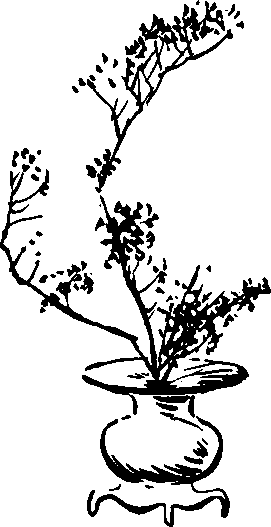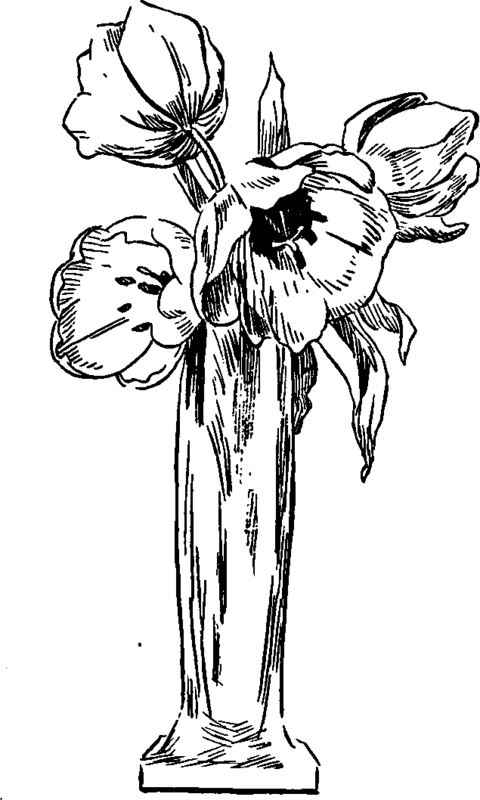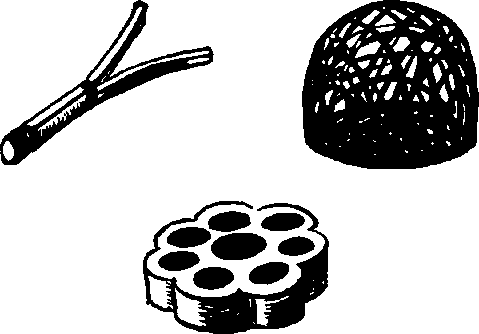Chapter IV. How to Make Flower Arrangements (Ike-Bana and Modern Styles)
Description
This section is from the book "Feeling Better? Amusements and Occupations for Convalescents", by Cornelia R. Trowbridge. Also available from Amazon: Feeling Better.
Chapter IV. How to Make Flower Arrangements (Ike-Bana and Modern Styles)
WHEN your friends "Say It with Flowers," are you getting all the pleasure possible from their gifts if you leave to others the arranging of them? At the moment flowers come you may have to accept gratefully any disposal of them about your room that will let you enjoy their color, fragrance and fresh beauty. But by the next morning would you not like to experiment with them?
The Equipment
Call for your bed-table, a pair of scissors, some favorite vase or bowl or low dish and a flower holder. If there is no flower holder in the pantry of perforated glass or metal, one can be secured from the florist or the nearest five-and-ten. Have a pitcher of water and a towel beside your bed. If the flowers have been standing in plenty of water in some dark, cool place, they will be easier to work with.
The Problem
There are various things to consider before you begin. Get clear in your mind what you want to do. Suppose you have before you a round dish and have found a flower holder and you are arranging some roses to stand on a table near your bed on the level with your eyes and with the wall for a background. What added beauty can you bring out in a low bowl that does not show if they are massed in a tall vase? It is clear that the graceful lines of the growing plant can be brought out better and that the individual blossoms can be displayed to greater advantage. You will not be aiming at perfect symmetry, for Nature gets her subtle harmonies by other means. The height of the flower cluster must be proportioned to the diameter and height of the bowl. You will not want to crowd together too many flowers. Some of those you have may go into a vase, where they will afford a study in contrasted arrangements.
There are schools and fashions in arranging flowers as in everything else. Some flowers are effective for their shape, or line, some for their color, some for their size, or their beauty if used in masses, most of them for all three elements. In every field of design artists work with these same elements of composition, commonly known as line, color and mass. No school of flower arrangement neglects any one of them but different schools put the chief emphasis on different elements.
Ike-Bana
The Japanese, who have gone further than any "Western nation in the development of the art of flower arrangement, aim to bring out beauty of shape, or line. Their art, which they call Ike-Bana, or Living Flowers, is full of symbolism and convention. It originated in Buddhist temples as far back as 700 a. d. Three elements are the basis of every arrangement of flowers made according to its laws. They are variously called Heaven, Man and Earth, Air, Earth and Water, Father, Mother and Child. They must always be in a fixed proportion and relation to each other and be placed to create balance, not symmetry. Their lines must never cross. They must be united at the base to give the unity of a living plant springing from the surface of the water, which represents the soil. Buds, blossoms, foliage, even dead leaves may be combined to suggest a growing plant, but there must always be an uneven number of flowers or branches. The flowers are kept subordinate to the whole.
The seasons of the year have their special symbols in Ike-Bana. A spring arrangement will suggest to the initiated the winds of March or emphasize energy of

The Three Elements of Ike-Bana, Heaven, Man and Earth line and radiant color to typify the awakening of life after the sleep of winter. A summer composition will be full and spreading; one for December, sparse and severe. There are conventions regulating gifts of flowers for all such occasions as departures on journeys, weddings and feast days. The mastery of Ike-Bana is as much a part of the education of a Japanese girl as the Tea-Ceremony but it is not only a feminine accomplishment. Statesmen, soldiers and philosophers find recreation in practising it. It is a customary courtesy in Japan to offer to a guest flowers, a vase and tools that he may display his skill. The hosts must show intelligent appreciation in the praise they lavish on his masterpiece.
Japanese theories have had great influence in both Europe and America ever since Josiah Conder, Architect to the Imperial Japanese Government, published in 1892 his monumental work on The Flowers of Japan and the Art of Floral Arrangement. They have opened people's eyes to the beauty of the ways of growing things and of their structural lines; to the importance of line and proportion in any floral composition; and to the simplicity of means with which an effect may be produced. They have taught us that with the color and fragrance and grace of flowers, we can bring indoors also their strength, their vitality, their joy of life.
Massed Arrangements Of Flowers
Arrangements following the rigid laws of Ike-Bana, are not always the best ones to attempt. Massing of flowers may be more appropriate to the furnishings of a room or more suited to the season's luxuriance than
Japanese restraint is. What are known as the French Empire and the Victorian Schools use flowers in large quantities. Empire arrangements generally require light-colored flowers in gay but formal bouquets, set in vases of classical design. Victorian arrangements aim at solid, rich, orderly effects, with flowers of deeper colors. Old-fashioned garden flowers are most used in the simple, quiet, less compact arrangements of the Colonial type.
Modernistic Arrangements
Modernistic Art has applied its principles to the decorative use of flowers. It emphasizes contrast, severity and strength of line and extreme simplicity. A single perfect blossom of brilliant color in a chromium vase may give the final touch to a room furnished in modernistic style.
Unless you wish to make a study of the various schools, the furnishings of your room and the atmosphere you wish to create in it will decide what designs you will work out with the flowers that come to you. You will find a new challenge to your skill in every florist's box and every garden bouquet. Have you tulips? Peonies? Zinnias? Chrysanthemums? With every season new problems will arise. In winter grasses, berries, seed-vessels, branches of evergreens can be made into arrangements interesting for their novelty as well as their beauty.

Practical Hints
There are various practical details useful to know. Flowers may be revived by plunging them into hot water. It is claimed-but also denied!-that cold tea, salt or aspirin in the water will make flowers last longer. Charcoal will keep water fresh. The bark on sections of branches under water should be bruised or peeled off. Flower holders come in many designs. Do not limit yourself to the "perforated pincushions of glass." Strips of lead an inch or two wide and ten to twelve inches long may be bent into holders of unusual shapes, heavy enough to hold tall stems. Your plumber may be able to supply them. Metal rings may be suspended by a bent wire inside the rim of a vase or a stem may be supported by a coil of wire like a spring.

Continue to:


